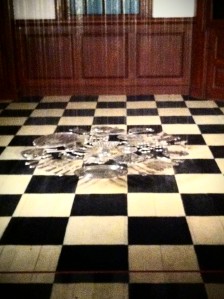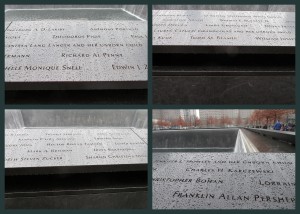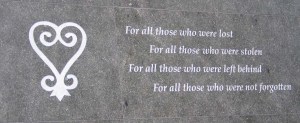On the fourth day we went to the Historic House Trust and ended up discussing how historic homes depict cultural memory in a very specific way. Often historic homes are restored to be pristine. Never does one see dirty dishes or laundry out at a historic home and I started to think about the implications of nice dinnerware and clean homes. The same goes for when we have guests over, most often the house is thoroughly cleaned and the best dishes are brought out. It is all about the performance of order, not chaos, which often homes can be as they are one’s private spaces. The dish example was very clear to me that just like we recreate historic homes, we also recreate the memory they hold. We sanitize the house and forget about the humans that lived in these places. The Alice Austen house proved to be a perfect example of this restoration process and it was hard to tell who lived in the house. Her photographs in the side room provided the most insight and unless one was really looking they may have missed how she viewed the world in which she lived.
The next night we went to a panel about gentrification at the Brooklyn Museum of Art and something I wondered as a couple panelists defended gentrification was could “we aim to make gentrification more human?” But I really questioned how could gentrification, something that tries to make areas look so tidy and put together like the historical homes, be more human, when humans sometimes leave dirty dishes in the sink? All humor aside, I had just begun an immersion experience, which would show us the lack of concern for some cultural narratives, the dirty underbelly in New York City.
After listening to the panel on gentrification, I decided to crutch up to the second floor to look at Judy Chicago’s The Dinner Party.
I could not help but go back to the conversation at the Historic House Trust because each table setting was beautifully ordered and decorated. Yet, this piece of feminist art from the 1970’s gave the these historically significant women a place at the table. In a way these beautiful tables subverted the traditional role of women, women who could be found setting and serving the table, because their lives were memorialized for their achievements outside the home. Each woman with her own table embodies and embodied what we have now labeled the feminist movement. I walked around the entire dinner table and at one point ended up in the corner of the floor. I saw photographs of the female body sculpted in sand, then I saw the following installation:

Cornelia Parker (English, b. 1956). Thirty Pieces of Silver (exhaled), 2003.
30 silver-plated objects, metal wire. Private collection
This art installation called, Thirty Pieces of Silver, pleasantly surprised me because I was engaged in an intense debate about dinner tables and silverware. The checkered floor took me to the 1950’s era and the silver hanging from the ceiling was fine silver. I read about the art and it stated, “This sculpture is made from scavenged collections of silverware that were first crushed by a 250-ton industrial press and then hung from wire. The violent flattening of the objects and their gravity-defying suspension just above the floor transform the silverware and relate to Parker’s interest in the concepts of death and resurrection. These themes are also implied by the work’s title, a reference to the coins for which Judas betrayed Christ.” The flattened silver, the violence of material culture, yet the hope for resurrection made my thoughts go multiple directions.
I was left questioning, have we, creators of cultural memory, been like Judas? Have we betrayed Christ’s gospel by judging others according to their dishes and silverware? What does it say about us to falsely depict historical homes and as a result tarnish cultural memory? I am still searching for these answers. But…
I came to the understanding, that ultimately, there is hope of resurrecting past narratives and preserving cultural memory as long as we are willing to look beyond the dishes.







